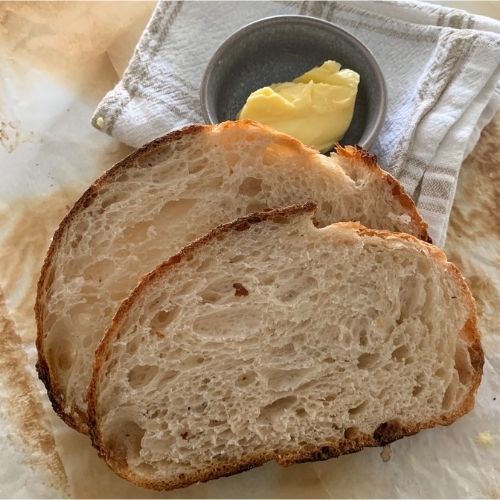Stand Mixer Sourdough Bread Recipe (Machine Mixed)
5.0
(5)
Your folders
Your folders
Prep Time: 120 minutes
Cook Time: 45 minutes
Servings: 1
Author : The Pantry Mama

Ingredients
Export 2 ingredients for grocery delivery
Instructions
Step 1
Pre MixUse the paddle attachment for this step: add your sourdough starter and water to the stand mixer bowl. Gently mix together for around 30 seconds or until the sourdough starter is dispersed through the water and the water is cloudy.
Step 2
Now use the dough hook: add your flour and salt to the sourdough starter and water in the stand mixer bowl. Knead for around 30 seconds or until it comes together in a shaggy dough.
Step 3
FermentolyseLeave dough to rest in the bowl for around 10 minutes (you can leave it up to around 30 minutes if you want to).
Step 4
KneadingUse the dough hook to knead the dough in 2 minute increments. This should take around 4 - 6 minutes.You'll know when the dough is done when you look into the bowl and see that there is a gap between the dough and the side of the bowl because the dough has formed a "ball". The dough will be elastic when you pull it up and have quite a bit of stretch.
Step 5
Bulk FermentationRemove the stand mixer bowl from the appliance and cover with a plastic cover. Now leave the dough to bulk ferment (see notes).It's ok to leave the dough to bulk ferment in either glass, ceramic or stainless steel.
Step 6
ShapingUse a silicon spatula to gently ease the dough out of the bowl. You want it to land "upside down" with the smooth top of the dough at the bottom and the sticky underneath on the top. This will make it very easy to shape.Using your hands, pull the top the dough into the centre so that it starts to form a ball. Once all the edges are in the centre, turn the dough over so that the smooth dough is at the top. Using the sticky underside, gently tension the dough so that it forms a ball.
Step 7
You will need a banneton to put your dough into. If you do not have a banneton, then a bowl or basket lined with a floured tea towel is perfectly fine. Make sure your bowl isn't too big though, you want your dough to retain some shape.Whatever you're using needs to be liberally floured with your rice flour. If you're using a banneton - liberally sprinkle it with rice flour. If you're using a cloth or tea towel, rub the flour into it to ensure it becomes non stick.Once the dough is shaped into a tight ball, place it into your banneton smooth side down, so your seam is on the top - this way the top of your dough will get the pretty lines from the banneton. If you're using a cloth or tea towel in a bowl it's ok to put your dough with the smooth side up. Just make sure the dough is tight.Lift your dough around the edges to pop a little more rice flour if you feel it needs it. Just try to handle the dough as little as possible and be really gentle as you really want to preserve all the gases and air bubbles that have formed during your bulk ferment.
Step 8
Cold FermentationNow your dough is in it's "shaping container" cover it loosely with a plastic bag or damp tea towel and place into the fridge. I use a large plastic bag to cover it - I just reuse it each time. It's not totally essential to cover it - you can place it in the fridge uncovered if you'd prefer.Try to leave it in the fridge for a minimum 5 hours up to a maximum of around 36 hours. The longer you leave it the better your bread will be! A longer cold ferment creates beautiful blisters on your crust and a deeper sourdough flavour. It will also ensure your dough forms a skin which makes it easier to score.
Step 9
Once you're ready to bake your sourdough, you'll need to preheat your oven to 230C/450F. Place your Dutch Oven into the oven when you turn it on so it gets hot. Try to preheat for around 1 hour to ensure your oven is super hot - but you know your oven so just adjust this time if you need to.Leave your dough in the fridge until the very last minute - placing a cold dough into a hot oven will give you a great "spring".
Step 10
BakingNow it's time to bake!When your oven is at temperature. Take your sourdough out of the fridge. Gently place it onto a piece of baking paper. Make sure that you make the baking paper big enough to use the edges as a handle to lower to dough into your Dutch Oven.Gently score your bread with a lame, clean razor blade or knife. At minimum a large cross is sufficient, but you can get as artistic as you like. Try to score it fairly deep to ensure the dough opens up.
Step 11
Carefully take your dutch oven out of the oven. Place the sourdough into the pot using the baking paper as a handle. Put the lid on and place into the hot oven. If you want to you can spritz your dough with extra water before you put the lid on.If you're worried about the base of your bread burning, place a baking sheet on shelf underneath your Dutch Oven - it works!BAKE TIME:Bake your sourdough for 30 minutes with the lid on at 230C/450F plus10 minutes with the lid off at 210C/
Step 12
When you remove your dough from the oven, carefully remove it from the dutch oven as soon as possible and place on a wire rack to cool.